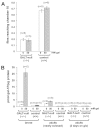Mediators of a long-term movement abnormality in a Drosophila melanogaster model of classic galactosemia
- PMID: 22736462
- PMCID: PMC3484862
- DOI: 10.1242/dmm.009050
Mediators of a long-term movement abnormality in a Drosophila melanogaster model of classic galactosemia
Abstract
Despite neonatal diagnosis and life-long dietary restriction of galactose, many patients with classic galactosemia grow to experience significant long-term complications. Among the more common are speech, cognitive, behavioral, ovarian and neurological/movement difficulties. Despite decades of research, the pathophysiology of these long-term complications remains obscure, hindering prognosis and attempts at improved intervention. As a first step to overcome this roadblock we have begun to explore long-term outcomes in our previously reported GALT-null Drosophila melanogaster model of classic galactosemia. Here we describe the first of these studies. Using a countercurrent device, a simple climbing assay, and a startle response test to characterize and quantify an apparent movement abnormality, we explored the impact of cryptic GALT expression on phenotype, tested the role of sublethal galactose exposure and galactose-1-phosphate (gal-1P) accumulation, tested the impact of age, and searched for potential anatomical defects in brain and muscle. We found that about 2.5% residual GALT activity was sufficient to reduce outcome severity. Surprisingly, sublethal galactose exposure and gal-1P accumulation during development showed no effect on the adult phenotype. Finally, despite the apparent neurological or neuromuscular nature of the complication we found no clear morphological differences between mutants and controls in brain or muscle, suggesting that the defect is subtle and/or is physiologic rather than structural. Combined, our results confirm that, like human patients, GALT-null Drosophila experience significant long-term complications that occur independently of galactose exposure, and serve as a proof of principle demonstrating utility of the GALT-null Drosophila model as a tool for exploring genetic and environmental modifiers of long-term outcome in GALT deficiency.
Figures






Similar articles
-
Acute and long-term outcomes in a Drosophila melanogaster model of classic galactosemia occur independently of galactose-1-phosphate accumulation.Dis Model Mech. 2016 Nov 1;9(11):1375-1382. doi: 10.1242/dmm.022988. Epub 2016 Aug 24. Dis Model Mech. 2016. PMID: 27562100 Free PMC article.
-
A Drosophila melanogaster model of classic galactosemia.Dis Model Mech. 2010 Sep-Oct;3(9-10):618-27. doi: 10.1242/dmm.005041. Epub 2010 Jun 2. Dis Model Mech. 2010. PMID: 20519569 Free PMC article.
-
Oxidative stress contributes to outcome severity in a Drosophila melanogaster model of classic galactosemia.Dis Model Mech. 2013 Jan;6(1):84-94. doi: 10.1242/dmm.010207. Epub 2012 Jul 5. Dis Model Mech. 2013. PMID: 22773758 Free PMC article.
-
Drosophila melanogaster Models of Galactosemia.Curr Top Dev Biol. 2017;121:377-395. doi: 10.1016/bs.ctdb.2016.07.009. Epub 2016 Aug 3. Curr Top Dev Biol. 2017. PMID: 28057307 Free PMC article. Review.
-
Galactosemia: when is it a newborn screening emergency?Mol Genet Metab. 2012 May;106(1):7-11. doi: 10.1016/j.ymgme.2012.03.007. Epub 2012 Mar 21. Mol Genet Metab. 2012. PMID: 22483615 Review.
Cited by
-
Overelaborated synaptic architecture and reduced synaptomatrix glycosylation in a Drosophila classic galactosemia disease model.Dis Model Mech. 2014 Dec;7(12):1365-78. doi: 10.1242/dmm.017137. Epub 2014 Oct 17. Dis Model Mech. 2014. PMID: 25326312 Free PMC article.
-
Pathophysiology and targets for treatment in hereditary galactosemia: A systematic review of animal and cellular models.J Inherit Metab Dis. 2020 May;43(3):392-408. doi: 10.1002/jimd.12202. Epub 2020 Jan 14. J Inherit Metab Dis. 2020. PMID: 31808946 Free PMC article.
-
Cryptic residual GALT activity is a potential modifier of scholastic outcome in school age children with classic galactosemia.J Inherit Metab Dis. 2013 Nov;36(6):1049-61. doi: 10.1007/s10545-012-9575-x. Epub 2013 Jan 15. J Inherit Metab Dis. 2013. PMID: 23319291 Free PMC article.
-
A pilot study of neonatal GALT gene replacement using AAV9 dramatically lowers galactose metabolites in blood, liver, and brain and minimizes cataracts in GALT-null rat pups.J Inherit Metab Dis. 2021 Jan;44(1):272-281. doi: 10.1002/jimd.12311. Epub 2020 Sep 17. J Inherit Metab Dis. 2021. PMID: 32882063 Free PMC article.
-
Manganese-based superoxide dismutase mimics modify both acute and long-term outcome severity in a Drosophila melanogaster model of classic galactosemia.Antioxid Redox Signal. 2014 May 20;20(15):2361-71. doi: 10.1089/ars.2012.5122. Epub 2013 Jul 20. Antioxid Redox Signal. 2014. PMID: 23758052 Free PMC article.
References
-
- Akai S. (1979). Genetic variation in walking ability of Drosophila melanogaster. Jpn. J. Genet. 54, 317–324
-
- Beutler E., Baluda M. L., Sturgeon P., Day R. W. (1965). A new genetic abnormality resulting in galactose-1-phosphate uridyltransferase deficiency. Lancet 1, 353–354 - PubMed
-
- Fridovich-Keil J. L., Walter J. H. (2008). Galactosemia. In The Online Metabolic & Molecular Bases of Inherited Disease (ed. Valle D., Beaudet A., Vogelstein B., Kinzler K., Antonarakis S., Ballabio A.), part 7, ch. 72. New York: McGraw Hill
Publication types
MeSH terms
Substances
Grants and funding
LinkOut - more resources
Full Text Sources
Medical
Molecular Biology Databases
Research Materials

